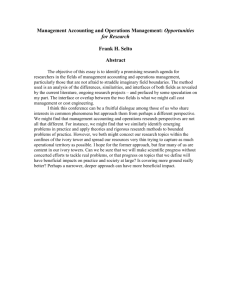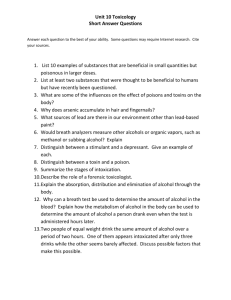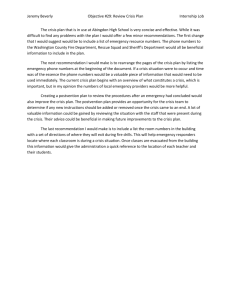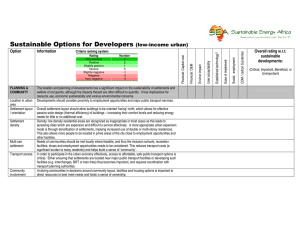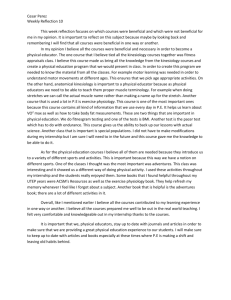Sustainable Options for Developers - OVERVIEW Option Information
advertisement
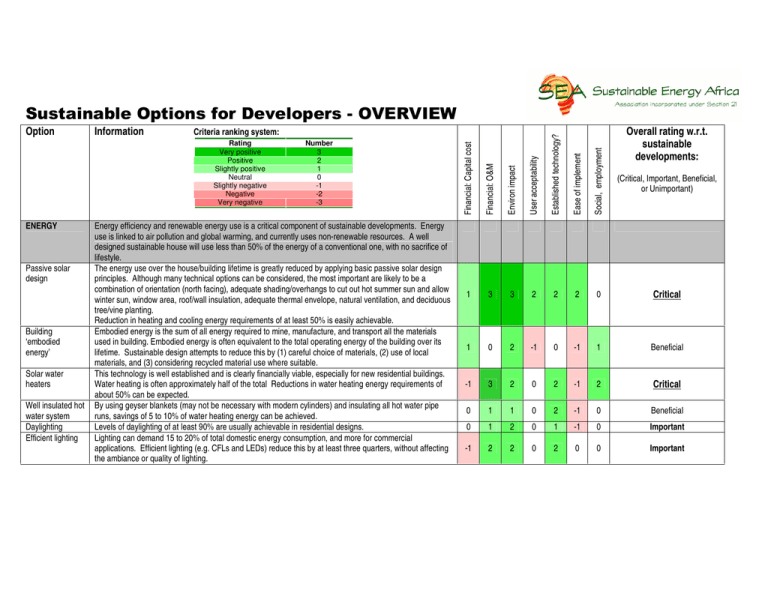
Sustainable Options for Developers - OVERVIEW Solar water heaters Well insulated hot water system Daylighting Efficient lighting Social, employment Building ‘embodied energy’ Ease of implement Passive solar design Energy efficiency and renewable energy use is a critical component of sustainable developments. Energy use is linked to air pollution and global warming, and currently uses non-renewable resources. A well designed sustainable house will use less than 50% of the energy of a conventional one, with no sacrifice of lifestyle. The energy use over the house/building lifetime is greatly reduced by applying basic passive solar design principles. Although many technical options can be considered, the most important are likely to be a combination of orientation (north facing), adequate shading/overhangs to cut out hot summer sun and allow winter sun, window area, roof/wall insulation, adequate thermal envelope, natural ventilation, and deciduous tree/vine planting. Reduction in heating and cooling energy requirements of at least 50% is easily achievable. Embodied energy is the sum of all energy required to mine, manufacture, and transport all the materials used in building. Embodied energy is often equivalent to the total operating energy of the building over its lifetime. Sustainable design attempts to reduce this by (1) careful choice of materials, (2) use of local materials, and (3) considering recycled material use where suitable. This technology is well established and is clearly financially viable, especially for new residential buildings. Water heating is often approximately half of the total Reductions in water heating energy requirements of about 50% can be expected. By using geyser blankets (may not be necessary with modern cylinders) and insulating all hot water pipe runs, savings of 5 to 10% of water heating energy can be achieved. Levels of daylighting of at least 90% are usually achievable in residential designs. Lighting can demand 15 to 20% of total domestic energy consumption, and more for commercial applications. Efficient lighting (e.g. CFLs and LEDs) reduce this by at least three quarters, without affecting the ambiance or quality of lighting. Overall rating w.r.t. sustainable developments: Established technology? ENERGY Number 3 2 1 0 -1 -2 -3 User acceptability Rating Very positive Positive Slightly positive Neutral Slightly negative Negative Very negative Environ impact Criteria ranking system: Financial: O&M Information Financial: Capital cost Option (Critical, Important, Beneficial, or Unimportant) 1 3 3 2 2 2 0 Critical 1 0 2 -1 0 -1 1 Beneficial -1 3 2 0 2 -1 2 Critical 0 1 1 0 2 -1 0 Beneficial 0 1 2 0 1 -1 0 Important -1 2 2 0 2 0 0 Important Efficient space (internal) heating & cooling Use of alien wood for heating, braais Biogas energy Efficient appliances Bio-fuels production and use Renewable electricity generation (solar PV or wind generation sources are often the most feasible) represents a significant commitment to a sustainable development. Costs are often relatively high, even considered over system lifetime (although solar PV costs are set to reduce dramatically in the next year). Systems may be (1) stand alone – where each house generates power and stores it in batteries for ownuse, (2) mini-grid – where houses share generation sources, or (3) grid-tied – where power not used by the development automatically feeds back into the area electricity network, and the development is credited accordingly. The latter is most financially feasible, as it allows maximum power extraction from the renewable system, and allows use of grid power during peak times. Hydro generation is potentially a low-cost electricity source if adequate perennial water flow is assured. Caution: Local authority position on feed-in of renewable power to existing grid needs to be established (this is a relatively new concept for many of them, although it is being done in several cities) While passive solar design should always be employed first to reduce space heating and cooling energy requirements, some active heating and cooling energy may be required. Here (1) heat pumps, (2) evaporative coolers, and (3) solar under-floor heating are more efficient options than standard aircon units. Where available, alien wood burning indoors for heating is an environmentally sound option (wood burning is considered ‘carbon-neutral’ - i.e. does not contribute to global warming). It’s use for braais is also preferable to importing wood to the area. Methane production from organic waste materials is an option where adequate suitable organic waste (including sewage) is produced. Methane gas generated can be used for cooking, heating, or even electricity generation. Caution: Acceptability of local sewage biogas systems may be an issue in upmarket developments, both from an aesthetic perception and maintenance point of view In addition to those mentioned above, appliances such as fridges consume a significant amount of energy (around 15% of household energy for fridges), and more efficient models should be considered. Technical and financial demands of bio-fuel production make this an unlikely component of a residential development. Options are: (1) Biodiesel crops may be viable in the area, but production facilities and competition with food crops are likely to render it unviable. (2) Bioethanol – usually considered where high sugar content produce is available (such as waste fruit) (3) Biodiesel from waste food oil – this is financially feasible, but requires a steady and substantial source of such oil. Overall rating w.r.t. sustainable developments: -2 1 3 2 2 -2 0 Important (NB: costs vary significantly between options - requires more disaggregated assessment - costs of some renewable options are also reducing fast – becoming increasingly viable) -2 1 2 1 2 -2 0 Beneficial 0 0 1 1 0 0 1 Beneficial Ease of implement (Critical, Important, Beneficial, or Unimportant) User acceptability Social, employment Renewable electricity generation (PV, wind…) Number 3 2 1 0 -1 -2 -3 Environ impact Rating Very positive Positive Slightly positive Neutral Slightly negative Negative Very negative Established technology? Criteria ranking system: Financial: O&M Information Financial: Capital cost Option -2 1 2 -1 -1 -2 1 Beneficial (though’ some uncertainties attached to technology and user acceptance) -1 1 1 1 2 0 0 Beneficial -3 -1 2 0 -2 -2 2 Unimportant Use of local water resources (catchment area) Rainwater harvesting Efficient toilet flushing: Dual or multi-flush toilets Efficient showerheads Tap flow reducers Water-wise gardens Efficient irrigation Grey-water reuse South African houses are notoriously water wasteful. Savings of 30% to 60% are realizable with sensible design, gardens and fittings, without sacrificing health or comfort. Where local layout and terrain allows, water catchment and use for gardens/irrigation, or processing for local consumption may be feasible. Water processing plant costs must be compared with mains supply alternatives to determine financial feasibility. Rainwater harvesting from building roofs is an environmentally sensible options, although the cost of adequate rainwater storage is often relatively high, resulting in a slow payback. This option reduces water consumption volume substantially (toilets often use 30% of household water – this can be cut in half, or more, by efficient toilet flushing systems). System functionality or health is not compromised. Many efficient showerheads are available which reduce flow significantly, without affecting shower comfort (surprising, but true). Shower consumption is often around 15% of household water use, and reductions of a third to a half of shower water volume are easily achieved. Shower water reduction also reduces hot water energy needs, adding to the financial viability. Caution: Ensure that showerheads chosen are well designed and do not compromise the quality of the shower. Although taps usually compromise a relatively small part of total domestic consumption, flow reducers are low cost and appropriate for most hand basins, and potentially kitchen sinks as well. In normal mid and hi-income residences, gardens typically use a third of household water consumption. This can be reduced by approximately 70% through correct choice of plants (mainly indigenous) , group planting, mulching etc. Choice of garden or agricultural irrigation system affects water consumption greatly. Drip irrigation systems, although substantially more expensive, save over 80% or water compared with conventional sprinklers, for example. Grey water (washing, shower, bath, hand basins) can be used for garden irrigation (with the exception of some protea family). Plumbing needs to facilitate grey water system installation in the construction phase, as retrofitting is usually difficult. Depending on the system used, costs and payback period can be reasonable. Caution: Grey water is not to be used for food garden irrigation. Local authorities may have concerns around grey water use; particularly near rivers (internationally there is still debate around suitability of untreated grey water use). Overall rating w.r.t. sustainable developments: -1 -1 1 0 -1 -1 0 Beneficial (feasibility depends on design and costing compared with available mains options) -2 1 1 1 3 -1 0 Beneficial -1 2 2 0 2 -1 0 Important -1 1 2 0 2 0 0 Important (significant benefit for little cost) -1 1 1 0 3 0 0 Beneficial 0 2 2 1 2 -1 0 Important -2 2 2 1 1 -1 0 Beneficial (significant saving, but significant cost) -1 1 1 -1 1 -1 0 Beneficial Ease of implement (Critical, Important, Beneficial, or Unimportant) User acceptability Social, employment WATER Number 3 2 1 0 -1 -2 -3 Environ impact Rating Very positive Positive Slightly positive Neutral Slightly negative Negative Very negative Established technology? Criteria ranking system: Financial: O&M Information Financial: Capital cost Option Efficient appliances WASTE REDUCTION/ RECYCLING Facilities for organic waste composting Facilities for recycling CHEMICALS /TOXINS Solvent free paints & finishes Household chemical alternatives Organic gardens and food production Several systems exist for treatment of sewage other than through piped sewerage systems and centralized treatment plants. These include ‘Biolytix’ systems, dry composting systems, local bacterial treatment and reed bed systems. Some systems are very expensive, others more financially viable. Costs need to be compared to centralized mainstream treatment options. Caution: Authorities are particularly sensitive to black water release into the ground near rivers. Dry composting systems need to be considered in the light of user perceptions in up-market developments. Washing machines and dishwashers are available which are much more water efficient than standard models. Households produce large quantities of waste, and the standard solution of simply removing it to landfill is recognized as unsustainable. Waste volume reduction of 60% can be realised in a sustainable settlement. Dumping of organic waste to landfill is environmentally nonsensical. This should be composted and nutrients returned to the soil (or possibly used for methane production – see earlier). Facilities for composting of organics should be considered – either centrally for the whole development, or on a perhousehold basis. Caution: Fly and other pest control around composting facilities may require some attention. Recycling (tins, paper, glass, metal and possibly plastics) should be promoted – by both centralized collection depots as well as within the residences. Here various multi-bin systems are available, and should be catered for in the design phase. Recycling sorting and sales can provide an employment creation opportunity. Caution: Availability of recycling facilities in nearby towns will affect the feasibility of such efforts. The steady accumulation of harmful synthetic compounds is a cause of global concern, and the long-term impacts on ecosystems are still mostly unknown. Sustainable developments should seek to minimize the use of such chemicals. There are several good quality, environmentally preferable masonry and wood finishes on the market in the country. Solvent content in paints and wood treatment products are to be avoided. Water and cementbased alternatives should rather be considered. Chemicals used in normal suburban house typically have significant harmful content – both for humans (surprisingly) as well as for the natural environment. Households should be encouraged to choose more environmentally sound options, especially if grey and or black water is being processed and released locally. Use of non-organic pesticides, herbicides and fertilizers is to be discouraged. Proven organic options are available. Overall rating w.r.t. sustainable developments: -2 -1 1 -1 1 -1 0 Beneficial (some benefits, but costs may be significant, and impact on groundwater is an issue needs basic design to assess further) -1 1 1 1 2 0 0 Beneficial -1 -1 2 1 2 -1 1 Important -1 0 1 1 0 -1 2 Important (particularly employment creation potential) 0 0 1 1 1 -1 0 Beneficial 0 0 2 1 2 -1 1 Important 0 -1 2 0 2 -1 0 Beneficial Ease of implement (Critical, Important, Beneficial, or Unimportant) User acceptability Social, employment Black water (sewage) treatment Number 3 2 1 0 -1 -2 -3 Environ impact Rating Very positive Positive Slightly positive Neutral Slightly negative Negative Very negative Established technology? Criteria ranking system: Financial: O&M Information Financial: Capital cost Option Social, employment Pets etc interference with wildlife LOCAL ECONOMY Local agriculture production Ease of implement Reduced fencing Minimal ‘footprint’ Overall rating w.r.t. sustainable developments: Established technology? LOCAL ECOSYSTEM Alien control and use Number 3 2 1 0 -1 -2 -3 User acceptability Rating Very positive Positive Slightly positive Neutral Slightly negative Negative Very negative Environ impact Criteria ranking system: Financial: O&M Information Financial: Capital cost Option (Critical, Important, Beneficial, or Unimportant) -1 -1 3 3 0 -2 2 Critical 1 0 1 1 0 2 0 Beneficial 1 2 2 0 0 1 0 Important 0 0 1 1 0 -1 0 Beneficial 2 Beneficial 3 Important 3 Beneficial Biodiversity and ecosystem preservation is central to sustainable growth. Alien invader species need to be controlled or eradicated (depending on threat classification). Local fynbos should be protected. Alien clearing provides employment creation opportunities (some organizations make and sell craft from alien vegetation). Movement of fauna should not be restricted unnecessarily. Reduced plot and house sizes, minimal roads, alternative road surfacing and reduced paving area, all reduce the impact on the local ecosystem. There is often no cost implication to such a lower impact approach – just requiring consideration in the conceptual phase. Domestic pets can have a significant impact on the immediate fauna in the immediate environment (dogs killing buck, cats hunting birds), and limiting the free-range of pets is sensible. A sustainable development should explicitly promote local economic growth and poverty alleviation. The development should not reduce local arable land area or utilization. Food production for local residents of the development should be encouraged. 0 0 0 1 0 1 Caution: Pesticide use is standard agricultural practice. With the proximity of residences, this will need to be monitored, and preferably changed to less harmful alternatives. Employment Construction, alien clearing, and recycling systems are all opportunities to maximize local employment creation creation. In addition, options listed elsewhere, such as solar water heaters, generate significantly more 0 0 0 0 -1 employment than conventional alternatives. It must be remembered that construction employment is a short- -1 term benefit. However, residents may also employ locals in gardens etc in the longer-term. Unemployment is a huge national priority, and needs to be a clear factor in any sustainable development. Poverty Assigning an area of land for food production for local poor communities, as well as for crops to be sold to alleviation the wealthier residents of the development, should be considered. This would support the poor financially -1 0 0 0 0 -1 as well as nutritionally. Organisations such as Abalimi Bezehaya could be invited to work with local communities to this end. Note on pollution: light, noise and air pollution are not dealt with here, as they are either not significant sustainability issues, or are not relevant to most developments.
